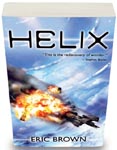Why you can trust 12DOVE
Author: Eric Brown
Publisher: Solaris
480 pages • £7.99
ISBN: 978-1-84416-472-1
Rating:

We’ve had Ringworld, Discworld and, in Arthur C Clarke’s Rama, Tube World (sort of). Now Eric Brown gives us SF’s first truly original Big Dumb Object in a long, long while in the shape of Helix, or, to use the metaphor he himself employs in the book, String of Beads World.
Helix is thousands of rotating, barrel-shaped worlds, separated by transitional seas, which are linked together in a series of tiers, spiralling around a central sun. Each world has its own ecosystem and its own inhabitants with their own individual societies and belief system. But who built it, and why? That’s what a bunch of refugees from a dying Earth need to find out when their ship crash-lands there, because if there’s a spare world going handy then they have a bunch of potential colonists on ice in the hold ready to be woken up.
Helix is a gloriously old-fashioned slice of science fiction. Despite exploring themes of faith (not just in terms of religious faith, but also how far you can trust “evidence”), secular humanism and whether humans have an innate desire for self-destruction, this is essentially a romp. As the humans set out from their crashed spaceship in little trucks to explore, you can’t help but be reminded of the opening episodes of Lost In Space. Then, as they begin to discover the various wonders and nightmares in each new world, the book takes on an almost Edgar Rice Burroughs feel.
What gives the novel a unique spin is its intertwining parallel plots. As well as the humans’ story, you also follow the lives of some lemur-like creatures living in a quasi-Victorian world, where a zealous “church” rules with an iron fist, teaching the populace that they are the only sentient creatures in the universe. An aeronautical engineer called Ehrin (these creatures travel by dirigibles) begins to challenge the church’s preachings, especially when he mounts an expedition that makes some disturbing discoveries which the ruling clergy would rather were kept secret.
The two plotlines orbit each other at first, before slowly intersecting in some surprising ways. It’s smart, fun, page-turning stuff, with an engaging cast and plenty of twists. Human stories – one of the colonists bears a long-standing grudge against one of the others; another is mourning the loss of his daughter – sit alongside mad spaceship dashes between worlds, last-minute rescues and daring escapes. Brown also carefully makes sure that all his various races (and there are more than the ones mentioned so far) have different languages, and has some fun playing with terminology, highlighting the fact that understanding is not a mere matter of translation. The lemurs, for example, don’t know what a smile is, so have no word to describe one, and assume that the humans are grimacing until they work out that it’s actually an expression of happiness.
On the downside, the book’s abundance of plot seems to come at the expense of a true “Wow!” factor. When the characters themselves seem to take everything in their stride it’s difficult for the reader to get excited about the wonders they’re witnessing. It’s a shame, because Brown serves up some startling ideas and images, but they never come across with the sense of grandeur he’s clearly aiming for. It’s a bit like trying to get an impression of the Grand Canyon from a postcard.
Some of the characters also act in such a stilted manner that you feel plot necessity is dictating their reactions, while the solution to the language barrier is convenient to say the least. Most surprising of all, though, is that a book which manages to keep you guessing for so much of its length has a climax that is less than jaw-dropping.
It’s not shamefully predictable, but neither is it much of a surprise for anyone well versed in science fiction. A hugely entertaining read, then, but it won’t turn your world inside out. Hmm, there’s an idea…
Dave Golder
SFX Magazine is the world's number one sci-fi, fantasy, and horror magazine published by Future PLC. Established in 1995, SFX Magazine prides itself on writing for its fans, welcoming geeks, collectors, and aficionados into its readership for over 25 years. Covering films, TV shows, books, comics, games, merch, and more, SFX Magazine is published every month. If you love it, chances are we do too and you'll find it in SFX.
Most Popular







